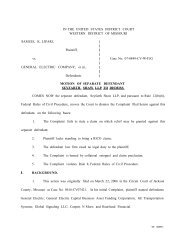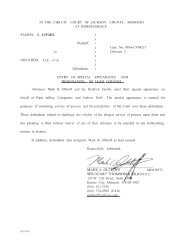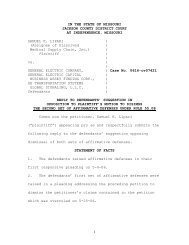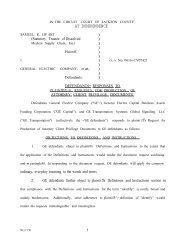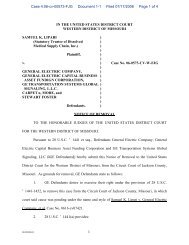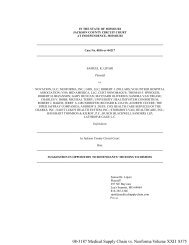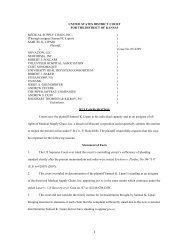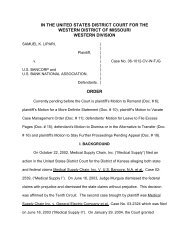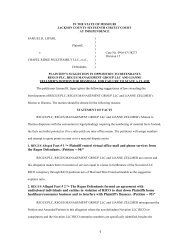Memorandum and Order on USBank Motion to Compel
Memorandum and Order on USBank Motion to Compel
Memorandum and Order on USBank Motion to Compel
Create successful ePaper yourself
Turn your PDF publications into a flip-book with our unique Google optimized e-Paper software.
DJW/bhSAMUEL K. LIPARI,IN THE UNITED STATES DISTRICT COURTFOR THE DISTRICT OF KANSASv.U.S. BANCORP, N.A., et al.,Plaintiff,Defendants.CIVIL ACTIONNo. 07-2146-CM-DJWMEMORANDUM AND ORDERThis matter is before the Court <strong>on</strong> Defendants’ Moti<strong>on</strong> <strong>to</strong> <strong>Compel</strong> Compliance with Rule26(a)(1) (doc. 68). For the reas<strong>on</strong>s set forth below, the Moti<strong>on</strong> is granted in part <str<strong>on</strong>g>and</str<strong>on</strong>g> denied in part.I. Background Informati<strong>on</strong>On April 20, 2007, Plaintiff served his initial disclosures pursuant <strong>to</strong> Federal Rule of CivilProcedure 26(a)(1). His disclosure statement listed 67 individuals <str<strong>on</strong>g>and</str<strong>on</strong>g> provided a genericidentificati<strong>on</strong> for each pers<strong>on</strong>, such as “Antitrust,” “Technology,” “C<strong>on</strong>tracting,” “Funding,” <str<strong>on</strong>g>and</str<strong>on</strong>g>“FBI.” Other individuals were identified <strong>on</strong>ly as “Witness.” No addresses or teleph<strong>on</strong>e numberswere provided for any of the 67 listed individuals.Plaintiff’s disclosure statement also listed thous<str<strong>on</strong>g>and</str<strong>on</strong>g>s of documents, 1 many of which were<strong>on</strong>ly briefly described. 2Some of the documents were also identified by Bates Stamp Numbers.Accompanying the disclosure statement was a CD c<strong>on</strong>taining the documents listed in the disclosurestatement. The disc c<strong>on</strong>tains more than 11,000 pages of documents.1 The listing of documents is approximately 39 pages in length.2For example, documents were identified as “Neil Marsh Invoice,” “Article When PrivateGoes Public,” “Vendor Rating a GPO Model.”
After the instant Moti<strong>on</strong> <strong>to</strong> <strong>Compel</strong> was filed, Plaintiff served a supplemental disclosurestatement that lists the names of 34 individuals. All but <strong>on</strong>e of the 34 individuals listed in thesupplemental statement were also listed in the initial statement. Unlike the initial statement, thesupplemental statement provides addresses for 14 of the listed individuals.Defendants seek an order directing Plaintiff <strong>to</strong> amend his disclosures. Defendants c<strong>on</strong>tendthat Plaintiff’s witness disclosures are deficient because Plaintiff fails <strong>to</strong> provide the teleph<strong>on</strong>enumbers <str<strong>on</strong>g>and</str<strong>on</strong>g> addresses for the individuals disclosed, <str<strong>on</strong>g>and</str<strong>on</strong>g> the subjects of those individuals’knowledge. Defendants assert that Plaintiff’s document disclosures are deficient because Plaintiffhas disclosed thous<str<strong>on</strong>g>and</str<strong>on</strong>g>s of pages of documents that are not <strong>on</strong>ly irrelevant <strong>to</strong> his claims but do noteven pertain <strong>to</strong> this lawsuit. Defendants also c<strong>on</strong>tend that Plaintiff’s document disclosures aredeficient because the written listing of documents is “not organized by category.” 3In his brief opposing the Moti<strong>on</strong> <strong>to</strong> <strong>Compel</strong>, Plaintiff explains that he “has now supplementedhis disclosures <strong>to</strong> include the addresses he knows,” 4 but states that “[t]he majority ofwitnesses . . . come from the defendants.” 5 He also states that in his initial disclosures he “includedthe relevant documents <strong>to</strong> the plaintiff’s claims <str<strong>on</strong>g>and</str<strong>on</strong>g> factual averments in his complaint.” 6Inadditi<strong>on</strong>, he explains that he “has served the documents <strong>to</strong> the defendants in indexed form <strong>on</strong> ac<strong>on</strong>veniently searchable disc, with an informative descripti<strong>on</strong> of each.” 73 Defs.’ Mem. in Supp. of Defs.’ Mot. <strong>to</strong> <strong>Compel</strong> (doc. 70) at p. 4.4Pl.’s Mem. In Opp. <strong>to</strong> Defs.’ Mot. <strong>to</strong> <strong>Compel</strong> (doc. 75) at p. 1.5 Id. at p. 7.6 Id. at p.1.7Id. at p. 7.2
In their reply, Defendants state that it is unclear whether Plaintiff’s supplemental list of 34individuals is intended <strong>to</strong> replace the list of 67 individuals disclosed in Plaintiff’s initial disclosurestatement or whether it is simply another list that further identifies some of the initially disclosed67 individuals. In additi<strong>on</strong>, Defendants point out that Plaintiff has failed <strong>to</strong> provide the subjectmatter of the discoverable informati<strong>on</strong> known by any of the 34 individuals listed in the supplementaldisclosure statement. Defendants further state that the disc provided by Plaintiff is not searchable<str<strong>on</strong>g>and</str<strong>on</strong>g> is, in fact, password protected, which prevents the documents from being searched or re-createdin .pdf format. Defendants c<strong>on</strong>cede, however, that they have been able “<strong>to</strong> view” each of the 11,000pages of documents that are <strong>on</strong> the disc. 8II.Discussi<strong>on</strong>A. Disclosure of WitnessesRule 26(a)(1)(A)(i) provides for the disclosure of certain individuals who are likely <strong>to</strong> havediscoverable informati<strong>on</strong> about the case. It provides that a party must provide <strong>to</strong> the other parties:the name <str<strong>on</strong>g>and</str<strong>on</strong>g>, if known, the address <str<strong>on</strong>g>and</str<strong>on</strong>g> teleph<strong>on</strong>e number of eachindividual likely <strong>to</strong> have discoverable informati<strong>on</strong> –– al<strong>on</strong>g with thesubjects of that informati<strong>on</strong> –– that the disclosing party may use <strong>to</strong>support its claims or defenses, unless the use would be solely forimpeachment[.] 98 Defs.’ Reply (doc. 79) at p. 19Fed. R. Civ. P. 26(a)(1)(A)(i).3
Thus, under Rule 26(a)(1)(A)(i), Plaintiff was required <strong>to</strong> provide the following informati<strong>on</strong>about any individuals likely <strong>to</strong> have discoverable informati<strong>on</strong> that he may use <strong>to</strong> support his claimsor defenses:! pers<strong>on</strong>’s name;! pers<strong>on</strong>’s teleph<strong>on</strong>e number <str<strong>on</strong>g>and</str<strong>on</strong>g> address, if known by Plaintiff; <str<strong>on</strong>g>and</str<strong>on</strong>g>! the subject of the discoverable informati<strong>on</strong> known by that pers<strong>on</strong>.As noted above, Defendants fault Plaintiff’s witness disclosures for three main reas<strong>on</strong>s.First, Defendants c<strong>on</strong>tend that Plaintiff has failed <strong>to</strong> adequately identify the subject of thediscoverable informati<strong>on</strong> known by each individual. This Court has found <strong>on</strong>ly a h<str<strong>on</strong>g>and</str<strong>on</strong>g>ful of casesthat address the degree of specificity required under Rule 26(a)(1)(A)(i) regarding the subject of thediscoverable informati<strong>on</strong> known by the potential witness. 10 Some guidance, however, can begleaned from Federal Rule of Civil Procedure 26(g)(1), which provides that initial disclosures must10 See, e.g., Loba<strong>to</strong> v. Ford, No. 05-cv-01437-LTB-CBS, 2007 WL 2593485, at *5 (D. Colo.Sept. 5, 2007) (“While a party is not necessarily required <strong>to</strong> provide a minute recitati<strong>on</strong> of theputative witness’ knowledge, the Rule 26(a)(1)(A) disclosure should indicate briefly the general<strong>to</strong>pics <strong>on</strong> which such pers<strong>on</strong>s have knowledge.”); Hertz v. Luzenac Am., Inc., No. 04-cv-1961-LTB-CBS, 2006 WL 994431, at *7 (D. Colo. Apr. 13, 2006) (“[D]isclosures should provide the opposingparty with enough useful informati<strong>on</strong> <strong>to</strong> make informed decisi<strong>on</strong>s regarding discovery <str<strong>on</strong>g>and</str<strong>on</strong>g> trialpreparati<strong>on</strong>”); Sender v. Mann, 225 F.R.D. 645, 650-51 (D. Colo. 2004) (holding that disclosuresshould be complete <str<strong>on</strong>g>and</str<strong>on</strong>g> detailed <str<strong>on</strong>g>and</str<strong>on</strong>g> should give opposing party more than “a laundry list ofundifferentiated witnesses” <str<strong>on</strong>g>and</str<strong>on</strong>g> finding disclosures deficient where plaintiff identified brokers <str<strong>on</strong>g>and</str<strong>on</strong>g>inves<strong>to</strong>rs as “having knowledge regarding the sale of promissory notes <str<strong>on</strong>g>and</str<strong>on</strong>g> the amounts owed <strong>to</strong>them pursuant <strong>to</strong> such notes” or “in some instances, having knowledge of other schemes attemptedor c<strong>on</strong>templated by [Defendants]”); Crouse Cartage Co. v. Nat’l Warehouse Inv. Co., No. IP02-071CTK, 2003 WL 23142182, at *1 (S.D. Ind. 2003) (holding that “initial disclosures should becomplete <str<strong>on</strong>g>and</str<strong>on</strong>g> detailed, <str<strong>on</strong>g>and</str<strong>on</strong>g> should give the opposing party informati<strong>on</strong> as <strong>to</strong> the identificati<strong>on</strong> <str<strong>on</strong>g>and</str<strong>on</strong>g>locati<strong>on</strong> of pers<strong>on</strong>s with knowledge so that they can be c<strong>on</strong>tacted in c<strong>on</strong>necti<strong>on</strong> with the litigati<strong>on</strong>.”);see also generally City <str<strong>on</strong>g>and</str<strong>on</strong>g> County of San Francisco v. Tu<strong>to</strong>r-Saliba Corp., 218 F.R.D. 219, 221(N.D. Cal. 2003) (disclosures functi<strong>on</strong> “<strong>to</strong> assist the parties in focusing <str<strong>on</strong>g>and</str<strong>on</strong>g> prioritizing theirorganizati<strong>on</strong> of discovery.”).4
e based up<strong>on</strong> a “reas<strong>on</strong>able inquiry” by counsel or the disclosing party, <str<strong>on</strong>g>and</str<strong>on</strong>g> must be “complete <str<strong>on</strong>g>and</str<strong>on</strong>g>correct as of the time [they] are made.” 11 Guidance is also provided by the Advisory Committee’sNote <strong>to</strong> the 1993 amendments, which states that a “major purpose of the [Rule] is <strong>to</strong> accelerate theexchange of basic informati<strong>on</strong> about the case <str<strong>on</strong>g>and</str<strong>on</strong>g> <strong>to</strong> eliminate the paper work involved in requestingsuch informati<strong>on</strong>, <str<strong>on</strong>g>and</str<strong>on</strong>g> the rule should be applied in a manner <strong>to</strong> achieve those objectives.” 12Furthermore, the Advisory Committee explains:[The parties] are expected <strong>to</strong> disclose the identity of those pers<strong>on</strong>s who may be usedby them as witnesses or who, if their potential testim<strong>on</strong>y were known, mightreas<strong>on</strong>ably be expected <strong>to</strong> be deposed or called as a witness by any of the otherparties. Indicating briefly the general <strong>to</strong>pics <strong>on</strong> which such pers<strong>on</strong>s have informati<strong>on</strong>should not be burdensome, <str<strong>on</strong>g>and</str<strong>on</strong>g> will assist other parties in deciding which depositi<strong>on</strong>swill actually be needed. 13Thus, while a party is not required <strong>to</strong> provide a detailed narrative of the potential witness’knowledge, the Rule 26(a)(1)(A) disclosure should provide enough informati<strong>on</strong> that would allowthe opposing party <strong>to</strong> help focus the discovery that is needed <str<strong>on</strong>g>and</str<strong>on</strong>g> <strong>to</strong> determine whether a depositi<strong>on</strong>of a particular pers<strong>on</strong> identified as a potential witness might be necessary. Clearly, Plaintiff’switness disclosures do not meet this st<str<strong>on</strong>g>and</str<strong>on</strong>g>ard. It is difficult <strong>to</strong> underst<str<strong>on</strong>g>and</str<strong>on</strong>g> how Plaintiff’s genericdescripti<strong>on</strong>s of “Technology, “Communicati<strong>on</strong>s,”“FBI,” etc., for these potential witnesses could11Fed. R. Civ. P. 26(g)(1).12 Fed. R. Civ. P. 26(a) advisory committee’s note (1993 amendment); see also Biltrite Corp.v. World Road Markings, Inc., 202 F.R.D. 359, 362 (D. Mass. 2001) (“The obvious purpose of thedisclosure requirement of Rule 26(a)(1)(A) is <strong>to</strong> give the opposing party informati<strong>on</strong> as <strong>to</strong> theidentificati<strong>on</strong> <str<strong>on</strong>g>and</str<strong>on</strong>g> locati<strong>on</strong> of pers<strong>on</strong>s with knowledge so that they can be c<strong>on</strong>tacted in c<strong>on</strong>necti<strong>on</strong>with the litigati<strong>on</strong>. . . .”).13Fed. R. Civ. P. 26(a) advisory committee’s note (1993 amendment).5
help focus the discovery efforts of Defendants or assist Defendants in determining whether adepositi<strong>on</strong> of a particular listed individual might be necessary.Plaintiff may not excuse his compliance with this requirement merely because, as Plaintiffputs it, most of the identified individuals “come from the defendants.” 14The Rule requires thedisclosing party <strong>to</strong> identify those individuals who may have discoverable informati<strong>on</strong> that thedisclosing party may use <strong>to</strong> support its own claims <str<strong>on</strong>g>and</str<strong>on</strong>g> defenses. 15In other words, Plaintiff need<strong>on</strong>ly disclose those individuals that may have discoverable informati<strong>on</strong> that Plaintiff himself mayuse <strong>to</strong> support his claims or defenses. Once he makes that determinati<strong>on</strong> <str<strong>on</strong>g>and</str<strong>on</strong>g> identifies certainpers<strong>on</strong>s, he must provide a sufficient descripti<strong>on</strong> of the discoverable knowledge that he believes theypossess.Defendants also find fault with Plaintiff’s witness disclosures because Plaintiff fails <strong>to</strong> listaddresses for many of the individuals <str<strong>on</strong>g>and</str<strong>on</strong>g> fails <strong>to</strong> list teleph<strong>on</strong>e numbers for all of them. Also, it isunclear whether the supplemental disclosure statement is intended <strong>to</strong> merely supplement the initialdisclosure statement or <strong>to</strong> take its place.Rule 26(a)(1)(A)(i) requires the disclosing party <strong>to</strong> provide the name <str<strong>on</strong>g>and</str<strong>on</strong>g> teleph<strong>on</strong>e numbersof the individuals <strong>on</strong>ly “if known” by the disclosing party Thus, Plaintiff can be compelled <strong>to</strong>provide addresses <str<strong>on</strong>g>and</str<strong>on</strong>g> teleph<strong>on</strong>e numbers <strong>on</strong>ly if that informati<strong>on</strong> is known <strong>to</strong> him. Assuming thatinformati<strong>on</strong> is known <strong>to</strong> him, he is not excused from providing it merely because he believesDefendants already have knowledge of these individuals <str<strong>on</strong>g>and</str<strong>on</strong>g> their c<strong>on</strong>tact informati<strong>on</strong>.14 Pl.’s Mem. In Opp. <strong>to</strong> Defs.’ Mot. <strong>to</strong> <strong>Compel</strong> (doc. 75) at p. 7.15See Rule 26(a)(1)(A)(i) (party must disclose each individual “likely <strong>to</strong> have discoverableinformati<strong>on</strong> . . . that the disclosing party may use <strong>to</strong> support its claims or defenses, unless the usewould be solely for impeachment.” (Emphasis added.)6
In light of the foregoing, the Court directs Plaintiff <strong>to</strong> serve amended Rule 26(a)(1)(A)(i)disclosures that take the place of his initial <str<strong>on</strong>g>and</str<strong>on</strong>g> supplemental disclosures 16 <str<strong>on</strong>g>and</str<strong>on</strong>g> which providesufficiently detailed informati<strong>on</strong> regarding the subject of each potential witness’ knowledge. Inadditi<strong>on</strong>, the amended disclosures shall provide each individual’s address <str<strong>on</strong>g>and</str<strong>on</strong>g> teleph<strong>on</strong>e number,if known <strong>to</strong> Plaintiff. Finally, Plaintiff shall insure that any individuals listed are those who hebelieves are likely <strong>to</strong> have discoverable informati<strong>on</strong> that he may use <strong>to</strong> support his claims ordefenses in this particular lawsuit. These amended disclosures shall be served <strong>on</strong> Defendants byJuly 30, 2008.B. Disclosure of DocumentsRule 26(a)(1)(A)(ii) requires a party <strong>to</strong> provide <strong>to</strong> the other parties in the lawsuit “a copy ––or a descripti<strong>on</strong> by category <str<strong>on</strong>g>and</str<strong>on</strong>g> locati<strong>on</strong> –– of all documents, electr<strong>on</strong>ically s<strong>to</strong>red informati<strong>on</strong>, <str<strong>on</strong>g>and</str<strong>on</strong>g>tangible things that the disclosing party has in its possessi<strong>on</strong>, cus<strong>to</strong>dy, or c<strong>on</strong>trol <str<strong>on</strong>g>and</str<strong>on</strong>g> may use <strong>to</strong>support its claims or defenses, unless the use would be solely for impeachment.” 17 To comply withthe Rule, then, Plaintiff was required <strong>to</strong> provide Defendants with the following:! either a copy or a descripti<strong>on</strong> by category <str<strong>on</strong>g>and</str<strong>on</strong>g> locati<strong>on</strong>, of all documents, electr<strong>on</strong>icallys<strong>to</strong>red informati<strong>on</strong>, <str<strong>on</strong>g>and</str<strong>on</strong>g> tangible things;! that are in Plaintiff’s possessi<strong>on</strong>, cus<strong>to</strong>dy or c<strong>on</strong>trol; <str<strong>on</strong>g>and</str<strong>on</strong>g>! that Plaintiff may use <strong>to</strong> support his claims or defenses in this lawsuit.Defendants essentially argue that the first <str<strong>on</strong>g>and</str<strong>on</strong>g> third of these requirements have not meet satisfied.16This should end any c<strong>on</strong>fusi<strong>on</strong> as <strong>to</strong> whether the supplemental disclosures were intended<strong>to</strong> replace the initial disclosures.17Fed. R. Civ. P. 26(a)(1)(A)(ii).7
With respect <strong>to</strong> the first requirement, Defendants assert that Plaintiff’s written descripti<strong>on</strong>sof the indexed documents are “far from informative” 18 <str<strong>on</strong>g>and</str<strong>on</strong>g> that the disc of documents provided byPlaintiff is password protected so that Defendants cannot search it <str<strong>on</strong>g>and</str<strong>on</strong>g> cannot re-create thedocuments in .pdf format. Defendants do not dispute, however, that they have been able <strong>to</strong> reviewall of the documents that are found <strong>on</strong> the disc. 19The Court finds that Plaintiff has complied with the first requirement by providing the disc<strong>to</strong> Defendants. By doing so, Plaintiff, in effect, provided a “copy” (albeit in electr<strong>on</strong>ic form) of eachof the disclosed documents. The Rule is written in the disjunctive; Plaintiff may provide either acopy or a descripti<strong>on</strong> of the documents by category <str<strong>on</strong>g>and</str<strong>on</strong>g> locati<strong>on</strong>. As Plaintiff provided a copy, hewas not required <strong>to</strong> provide a descripti<strong>on</strong>. It is thus immaterial that he may have providedinsufficient descripti<strong>on</strong>s of his documents <strong>on</strong> his written index of documents. Furthermore, thereis no requirement that Plaintiff provide Defendant with a disc of the documents that is “searchable”or that allows the documents c<strong>on</strong>tained <strong>on</strong> it <strong>to</strong> be c<strong>on</strong>verted <strong>to</strong> .pdf format. Defendants c<strong>on</strong>cedethat they have been able <strong>to</strong> review each of the documents c<strong>on</strong>tained <strong>on</strong> the disc; thus, whether thedisc is searchable or allows the documents <strong>to</strong> be recreated in .pdf format is immaterial.With respect <strong>to</strong> the third requirement, Defendants argue that n<strong>on</strong>e of the thous<str<strong>on</strong>g>and</str<strong>on</strong>g>s of pagesof documents that Plaintiff has disclosed is relevant <strong>to</strong> this case. More specifically, Defendantsargue that Plaintiff’s disclosures are a duplicate of what he served in another case, Lipari, et al. v.General Electric, et al., Case No. 0616-CV7421, filed in the Circuit Court of Jacks<strong>on</strong> County,18 Defs.’ Reply (doc. 79) at p. 2.19 Id.8
Missouri (“General Electric case”). 20 According <strong>to</strong> Defendants, those documents are unrelated <strong>to</strong>this case because the General Electric case involves different defendants <str<strong>on</strong>g>and</str<strong>on</strong>g> different facts.Plaintiff argues that Defendants are incorrect when they argue that his document disclosuresmust be deficient because they are the same document disclosures made in the General Electriccase. Plaintiff argues that both this case <str<strong>on</strong>g>and</str<strong>on</strong>g> General Electric stem from the same underlying facts.He states that “both cases cover the same events <str<strong>on</strong>g>and</str<strong>on</strong>g> rely <strong>on</strong> the same determinati<strong>on</strong> of MedicalSupply Chain, Inc.’s income if [Defendants] had not breached their c<strong>on</strong>tracts with Medical SupplyChain, Inc.” <str<strong>on</strong>g>and</str<strong>on</strong>g> engaged in the other wr<strong>on</strong>gful acts alleged in Plaintiff’s Complaint. 21 Plaintifffurther states that he has disclosed “the documents related <strong>to</strong> the launch of his business <str<strong>on</strong>g>and</str<strong>on</strong>g> hisclaims against the defendants that the plaintiff will likely be using in court before a jury.” 22Not having reviewed the documents at issue <str<strong>on</strong>g>and</str<strong>on</strong>g> not being intimately familiar with the facts<str<strong>on</strong>g>and</str<strong>on</strong>g> allegati<strong>on</strong>s of this case, or for that matter, the General Electric case, the Court is not in apositi<strong>on</strong> <strong>to</strong> determine whether each <str<strong>on</strong>g>and</str<strong>on</strong>g> every document disclosed by Plaintiff is <strong>on</strong>e that he mightuse <strong>to</strong> support his claims <str<strong>on</strong>g>and</str<strong>on</strong>g> defenses. The Court declines <strong>to</strong> enter an order, based up<strong>on</strong> nothingmore than doubt <str<strong>on</strong>g>and</str<strong>on</strong>g> speculati<strong>on</strong>, that would require Plaintiff <strong>to</strong> remove certain documents from hisdisclosures. The Court will, however, direct Plaintiff <strong>to</strong> file a supplemental Rule 26(a)(1)(A)(ii)disclosure statement in which he makes an affirmative statement that the documents listed <strong>on</strong> hisinitial Rule 26(a)(1)(A)(ii) written disclosure statement, <str<strong>on</strong>g>and</str<strong>on</strong>g> c<strong>on</strong>tained <strong>on</strong> the disc provided <strong>to</strong>20 Plaintiff states that the General Electric case is now filed in the Western District ofMissouri, Case No. 07-0849-CV-W-FJG. Pl.’s Mem. in Opp. <strong>to</strong> Defs.’ Mot. <strong>to</strong> <strong>Compel</strong> (doc. 75)at p. 1.21 Id. at p.3.22Id. at p. 5.9
Defendants, are documents that he (1) has in his possessi<strong>on</strong>, cus<strong>to</strong>dy, or c<strong>on</strong>trol, <str<strong>on</strong>g>and</str<strong>on</strong>g> (2) may use<strong>to</strong> support his claims or defenses in this case. To the extent Plaintiff has disclosed documents thatfall outside of this definiti<strong>on</strong>, he shall serve amended document disclosures that comply with Rule26(a)(1)(a)(ii) <str<strong>on</strong>g>and</str<strong>on</strong>g> this <str<strong>on</strong>g>Memor<str<strong>on</strong>g>and</str<strong>on</strong>g>um</str<strong>on</strong>g> <str<strong>on</strong>g>and</str<strong>on</strong>g> <str<strong>on</strong>g>Order</str<strong>on</strong>g>. The supplemental disclosure statement or amendeddisclosures shall be served <strong>on</strong> Defendants by July 30, 2008.III.At<strong>to</strong>rney’s Fees <str<strong>on</strong>g>and</str<strong>on</strong>g> ExpensesDefendants do not expressly request an award of expenses or fees in c<strong>on</strong>necti<strong>on</strong> with theirMoti<strong>on</strong> <strong>to</strong> <strong>Compel</strong>; they merely “request all . . . relief <strong>to</strong> which they are justly entitled.” 23 The Courtmust look <strong>to</strong> Federal Rule of Civil Procedure 37(a)(5), which deals with the payment of expensesincurred in c<strong>on</strong>necti<strong>on</strong> with moti<strong>on</strong>s <strong>to</strong> compel. Subsecti<strong>on</strong> (C) provides for the payment of themoving party’s expenses if the moti<strong>on</strong> <strong>to</strong> compel discovery is granted in part. It provides that theCourt “may, after giving an opportunity <strong>to</strong> be heard, apporti<strong>on</strong> the reas<strong>on</strong>able expenses for themoti<strong>on</strong>.” 24To satisfy the requirement that the parties be given the opportunity <strong>to</strong> be heard, the Courtdirects Plaintiff <strong>to</strong> show cause, in a pleading filed <strong>on</strong> or before August 13, 2008, why he should notbe required <strong>to</strong> pay a porti<strong>on</strong> of the reas<strong>on</strong>able expenses <str<strong>on</strong>g>and</str<strong>on</strong>g> at<strong>to</strong>rney’s fees Defendants incurred inmaking their Moti<strong>on</strong> <strong>to</strong> <strong>Compel</strong>. Defendants shall have until August 24, 2008 <strong>to</strong> file a resp<strong>on</strong>sethere<strong>to</strong>, if they so choose. In the event the Court determines that expenses <str<strong>on</strong>g>and</str<strong>on</strong>g> fees should beawarded <str<strong>on</strong>g>and</str<strong>on</strong>g> apporti<strong>on</strong>ed, the Court will issue an order setting forth a schedule for the filing of an23 Defs.’ Mem. in Supp. of Mot. <strong>to</strong> <strong>Compel</strong> (doc. 70) at p. 5.24Fed. R. Civ. P. 37(a)(5)(C).10
affidavit reflecting the amount of expenses <str<strong>on</strong>g>and</str<strong>on</strong>g> fees that Defendants have incurred, <str<strong>on</strong>g>and</str<strong>on</strong>g> for the filingof any related briefs.IV.Other ReliefDefendants ask that the Court cauti<strong>on</strong> Plaintiff that any further discovery abuses may resultin severe sancti<strong>on</strong>s, including the possible dismissal of his claims. The Court declines <strong>to</strong> enter suchan order, finding that Defendants have not shown that Plaintiff has engaged in discovery abuses inc<strong>on</strong>necti<strong>on</strong> with his Rule 26(a)(1) disclosures.IT IS THEREFORE ORDERED that Defendants’ Moti<strong>on</strong> <strong>to</strong> <strong>Compel</strong> Compliance withRule 26(a)(1) (doc. 68) is granted in part <str<strong>on</strong>g>and</str<strong>on</strong>g> denied in part, as set forth herein..IT IS FURTHER ORDERED that, <strong>on</strong> or before July 30, 2008, Plaintiff shall serve anamended Rule 26(a)(1)(A)(i) witness disclosure statement in compliance with this <str<strong>on</strong>g>Memor<str<strong>on</strong>g>and</str<strong>on</strong>g>um</str<strong>on</strong>g><str<strong>on</strong>g>and</str<strong>on</strong>g> <str<strong>on</strong>g>Order</str<strong>on</strong>g>.IT IS FURTHER ORDERED that, <strong>on</strong> or before July 30, 2008, Plaintiff shall serve asupplemental Rule 26(a)(1)(A)(ii) document disclosure statement or amended Rule 26(a)(1)(A)(ii)document disclosures in compliance with this <str<strong>on</strong>g>Memor<str<strong>on</strong>g>and</str<strong>on</strong>g>um</str<strong>on</strong>g> <str<strong>on</strong>g>and</str<strong>on</strong>g> <str<strong>on</strong>g>Order</str<strong>on</strong>g>.IT IS FURTHER ORDERED that, <strong>on</strong> or before August 13, 2008, Plaintiff shall showcause in a pleading filed with the Court, why he should not be required <strong>to</strong> pay a porti<strong>on</strong> of thereas<strong>on</strong>able fees <str<strong>on</strong>g>and</str<strong>on</strong>g> expenses that Defendants incurred in making their Moti<strong>on</strong> <strong>to</strong> <strong>Compel</strong>.Defendants shall have until August 24, 2008 <strong>to</strong> file a resp<strong>on</strong>se there<strong>to</strong>.11
IT IS SO ORDERED.Dated in Kansas City, Kansas <strong>on</strong> this 22nd day of July 2008.s/ David J. WaxseDavid J. WaxseU.S. Magistrate Judgecc:All counsel <str<strong>on</strong>g>and</str<strong>on</strong>g> pro se parties12



